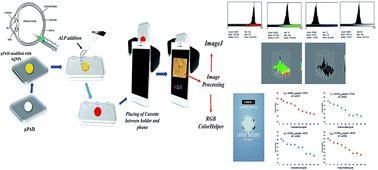Determination of cause of death using paper-based microfluidic device as a colorimetric probe†
Abstract
In recent years, the use of benzodiazepines has increased in the commission of crime, homicide, suicide, drugs overdoses, robbery, and drug-facilitated sexual assault. Assessment of drug exposure is also costly and resource-intensive because the analysis typically requires sophisticated instrumental techniques. Hence, driven by the need to detect alprazolam (ALP), we report a novel, simple, portable, disposable, and rapid inexpensive microfluidic paper-based analytical device (μPAD) for measuring ALP from vitreous humor and blood. This μPAD is embedded with silver nanoparticles for colorimetric detection and rapid quantification of alprazolam in different biological fluids using a smart phone. Under optimal conditions, the limit of detection is found to be 0.8 ng mL−1via a UV-vis spectrophotometer, whereas the limit of μPAD-based smart phone-enabled ALP detection is 10 ng mL−1. This μPAD was successfully applied to drug-exposed real samples of blood and vitreous humor. The proposed method provides mix and measure detection platform using a test paper and smart phone, which offers a new alternative for on-site detection especially in field situations of drugs in forensic cases and as point of care (POC) device for clinical diagnosis for toxicological drug screening. The device formed herein meets the criteria of the present-generation analytical devices in terms of portability, selectivity, sensitivity at the ng mL−1 level, cost effectiveness, simplicity, data transmission facility, and rapid on-site investigation.



 Please wait while we load your content...
Please wait while we load your content...